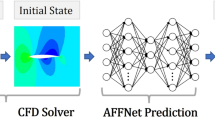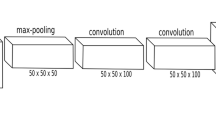Abstract
Nonlinear modes of the three-dimensional flow field around a cylinder were extracted by distributed learning on Fugaku. Mode decomposition is an approach used to decompose flow fields into physically important flow structures known as modes. In this study, convolutional neural network-based mode decomposition was applied to the three-dimensional flow field. However, because this process is costly in terms of calculation and memory usage for even a small flow field problem, the enormous computational and memory resources of the supercomputer Fugaku were employed. A hybrid parallelism method combining the distribution of network structure (model parallelism) and the input data (data parallelism) using up to 10,500 nodes on Fugaku was employed for learning. Further, we constructed a reduced-order model to predict the time evolution of latent vector, using the long short-term memory networks. Finally, we compared the reproduced flow field of the model with that of the original full-order model. In addition, we evaluated the execution performance of the learning process. Using a single core memory group, the whole learning process indicates a value of 129.50 GFLOPS being achieved, 7.57% of the single-precision floating-point arithmetic peak performance. Notably, the convolution calculation for backward-propagation achieved 1103.09 GFLOPS, which is 65.39% of the peak. Furthermore, with the weak scaling test, the whole learning process indicates 72.9% with 25,250 nodes (1,212,000 cores) relative to 750 nodes, the sustained performance is 7.8 PFLOPS. In particular, the convolution calculation for backward-propagation indicates a result of 113 PFLOPS (66.2% of the peak performance).
Access this chapter
Tax calculation will be finalised at checkout
Purchases are for personal use only
Similar content being viewed by others
Notes
- 1.
At the time of this calculation, Fugaku was not yet in operation.
- 2.
Single-precision is sufficient for precise learning and can increase FLOPS by utilizing the SIMD register.
- 3.
The first two modes, learned by two and 20 mode models, are not the same because if the number of modes when learning is different, the optimal set of modes to reconstruct the energy of the original field are different.
References
Taira, K., et al.: Modal analysis of fluid flows: an overview. AIAA J. 55(12), 4013–4041 (2017)
Jolliffe, I.T.: Principal Component Analysis, Springer Series in Statistics, 2nd edn. Springer, Heidelberg (2002)
Lumley, J.L.: The structure of inhomogeneous turbulent flows. In: Yaglom, A.M., Tatarski, V.I. (Eds.) Atmospheric Turbulence and Wave Propagation, pp. 166–178. Nauka (1967)
Holmes, P., Lumley, J.L., Berkooz, G., Rowley, C.W.: Turbulence, Coherent Structures, Dynamical Systems and Symmetry, 2nd edn. Cambridge University Press, Cambridge (2012)
Chatterjee, A.: An introduction to the proper orthogonal decomposition. Curr. Sci. 78(7), 808–817 (2000)
Berkooz, G., Holmes, P., Lumley, J.L.: The proper orthogonal decomposition in the analysis of turbulent flows. Annu. Rev. Fluid Mech. 25, 539–575 (1993)
Taira, K.: Proper orthogonal decomposition in fluid flow analysis: 1 introduction. Nagare 30, 115–124 (2011). (in Japanese)
Aubry, N., Holmes, P., Lumley, J.L., Stone, E.: The dynamics of coherent structures in the wall region of a turbulent boundary layer. J. Fluid Mech. 192, 115–173 (1988)
Noack, B.R., Morzynski, M., Tadmor, G.: Reduced-Order Modelling for Flow Control. Springer, Heidelberg (2011)
Taira, K., et al.: Modal analysis of fluid flows: applications and outlook. AIAA J. 58(3), 998–1022 (2020)
Kim, Y., Choi, Y., Widemann, D., Zohdi, T.: Efficient nonlinear manifold reduced order model (2020). https://arxiv.org/pdf/2011.07727.pdf
Murata, T., Fukami, K., Fukagata, K.: Nonlinear mode decomposition with convolutional neural networks for fluid dynamics. J. Fluid Mech. 882, A13 (2020). https://doi.org/10.1017/jfm.2019.822
Hasegawa, K., Fukami, K., Murata, T., Fukagata, K.: Machine-learning-based reduced-order modeling for unsteady flows around bluff bodies of various shapes. Theor. Comput. Fluid Dyn. 34(4), 367–383 (2020)
Hochreiter, S., Schmidhuber, J.: Long short-term memory. Neural Comput. 9, 1735–1780 (1997)
OLCF: Summit system overview (2018). https://www.olcf.ornl.gov/for-users/system-user-guides/summit/system-overview/
Patton, R.M., et al.: 167-PFlops deep learning for electron microscopy: from learning physics to atomic manipulation. In: SC18: International Conference for High Performance Computing, Networking, Storage and Analysis, Dallas, TX, USA, pp. 638–648 (2018). https://doi.org/10.1109/SC.2018.00053
Kurth, T., et al.: Exascale deep learning for climate analytics. In: Proceedings of the International Conference for High Performance Computing, Networking, Storage, and Analysis, SC 2018, p. 51. IEEE Press, NJ, USA (2018)
Yang, L., et al.: Highly-scalable, Physics-Informed GANs for Learning Solutions of Stochastic PDEs. In: 2019 IEEE/ACM Third Workshop on Deep Learning on Supercomputers (DLS), pp. 1–11, November 2019
Jia, W., et al.: Pushing the limit of molecular dynamics with ab initio accuracy to 100 million atoms with machine learning. In: 2020 SC20: International Conference for High Performance Computing, Networking, Storage and Analysis (SC), Atlanta, GA, US, pp. 1–14 (2020). https://doi.org/10.1109/SC41405.2020.00009
Yoshida, T.: Fujitsu high performance CPU for the post-K computer. Hot Chips 30, 1–22 (2018)
RIKEN Center for Computational Science, Specifications Post-K (Fugaku) Information. https://postk-web.r-ccs.riken.jp/spec.html
TOP500.org.: TOP500 Supercomputer Sites (2020)
RIKEN Center for Computational Science, Post-K (Fugaku) Information. https://postk-web.r-ccs.riken.jp/perf.html
RIKEN: Japan’s Fugaku retains title as the world’s fastest supercomputer. https://www.riken.jp/en/news_pubs/news/2020/20201117_2/index.html
RIKEN Center for Computational Science, Outline of the Development of the Supercomputer Fugaku. https://www.r-ccs.riken.jp/en/fugaku/project/outline
OneAPI Deep Neural Network Library (oneDNN). https://01.org/oneDNN
Deep Neural Network Library for AArch64. https://github.com/fujitsu/dnnl_aarch64
Paszke, A., et al.: Automatic differentiation in PyTorch. In: NIPS-W (2017)
Jansson, N., Bale, R., Onishi, K., Tsubokura, M.: CUBE: A scalable framework for large-scale industrial simulations. Int. J. High. Perform. Comput. App. 33(4), 678–698 (2019). https://doi.org/10.1177/1094342018816377
Onishi, K., Tsubokura, M.: Topology-free immersed boundary method for incompressible turbulence flows: an aerodynamic simulation for “dirty” CAD geometry. Comput. Method Appl. Mech. Eng. (2021). https://doi.org/10.1016/j.cma.2021.113734
Nakahashi, K.: Building-cube method for flow problems with broadband characteristic length. In: Armfield, S., Morgan, P., Srinivas, K. (Eds) Computational Fluid Dynamics, 77–81. Springer, Berlin Heidelberg (2003). https://doi.org/10.1007/978-3-642-59334-5_7
Onishi, K., Obayashi, S., Nakahashi, K., Tsubokura, M.: Use of the immersed boundary method within the building cube method and its application to real vehicle CAD Data. In: 21st AIAA Computational Fluid 1029 Dynamics Conference. American Institute of Aeronautics and Astronautics, San Diego, CA (2013). https://doi.org/10.2514/6.2013-2713
Peskin, C.S.: The immersed boundary method. Acta. Numerica. 11(1032), 479–517 (2002). https://doi.org/10.1017/S0962492902000077
Bhalla, A.P.S., Bale, R., Griffith, B.E., Patankar, N.A.: A unified mathematical framework and an adaptive numerical method for fluid-structure interaction with rigid, deforming, and elastic bodies. J. Comput. Phys. 250(1), 446–476 (2013). https://doi.org/10.1016/j.jcp.2013.04.033
Hinton, G.E., Salakhutdinov, R.R.: Reducing the dimensionality of data with neural networks. Science 313(5786), 504–507 (2006)
Olah, C.: Understanding LSTM Networks. http://colah.github.io/posts/2015-08-Understanding-LSTMs/. Accessed 04 Apr 2021
Nakamura, T., Fukami, K., Hasegawa, K., Nabae, Y., Fukagata, K.: Convolutional neural network and long short-term memory based reduced order surrogate for minimal turbulent channel flow. Phys. Fluids 33, 025116 (2021). https://doi.org/10.1017/jfm.2019.238
Acknowledgment
We sincerely appreciate the advice and support of Prof. Koji Fukagata, Mr. Kai Fukami, and Mr. Takaaki Murata of Keio University. This work used computational resources of the supercomputer Fugaku provided by RIKEN.
Author information
Authors and Affiliations
Corresponding author
Editor information
Editors and Affiliations
Rights and permissions
Copyright information
© 2021 Springer Nature Switzerland AG
About this paper
Cite this paper
Ando, K., Onishi, K., Bale, R., Tsubokura, M., Kuroda, A., Minami, K. (2021). Nonlinear Mode Decomposition and Reduced-Order Modeling for Three-Dimensional Cylinder Flow by Distributed Learning on Fugaku. In: Jagode, H., Anzt, H., Ltaief, H., Luszczek, P. (eds) High Performance Computing. ISC High Performance 2021. Lecture Notes in Computer Science(), vol 12761. Springer, Cham. https://doi.org/10.1007/978-3-030-90539-2_8
Download citation
DOI: https://doi.org/10.1007/978-3-030-90539-2_8
Published:
Publisher Name: Springer, Cham
Print ISBN: 978-3-030-90538-5
Online ISBN: 978-3-030-90539-2
eBook Packages: Computer ScienceComputer Science (R0)




